Return to theme table of contents
Return to VJIC table of contents
Essay # 9
AFTERMATH: Displaced Persons (DP) camps, Immigration and Emigration
© Robert Hirsch 2023
www.lightresearch.net
VASA Journal on Images and Culture (VJIC),
Theme Editor and Writer
“History Doesn’t Repeat Itself, but It Often Rhymes”
Attributed to Mark Twain (Samuel Clemens)
Displaced Persons (DP) camps
After Germany capitulated in May 1945, there were more than eight million “displaced” persons forced to leave their home country. To address the refugee problem generated by World War II, the Allies established Displaced Persons (DP) camps in the Allied-occupied zones of Austria, Germany, and Italy. The first occupants of these camps were concentration camp survivors who had been liberated by the Allies on German soil. Initially, conditions in these camps were extremely harsh as many of the DP camps were former concentration camps and German army camps. Survivors continued to find themselves locked behind barbed wire, subsisting on inadequate amounts of food and suffering from shortages of clothing, medicine, and supplies. Often, Jewish survivors suffered additional trauma because they were held in the same camps as German civilians and/or Nazi perpetrators. In the summer of 1945, President Harry Truman asked former U.S. immigration commissioner Earl Harrison to tour the DP camps. Harrison was shocked by what he found and informed Truman: “We appear to be treating the Jews as the Nazis had treated them, except that we do not exterminate them.” Based on Harrison’s report, the United States established separate camps for Jewish DPs.[i]
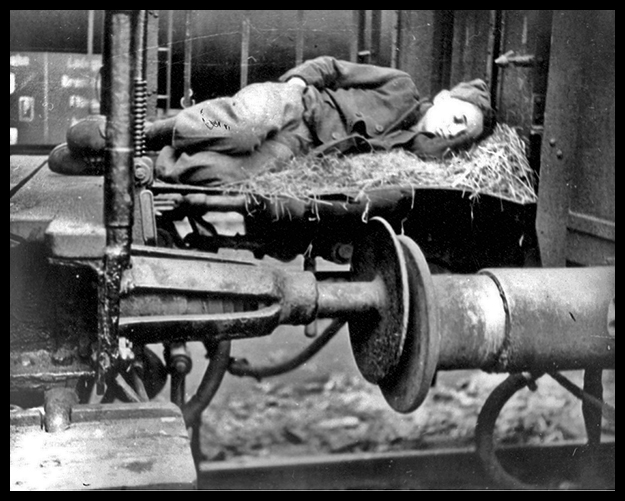
9.1 A Child Sleeping Between Train Cars on the Return Journey from Buchenwald to Hungary, circa 1945. Dimensions variable. Gelatin silver print. Yad Vashem Archives, Jerusalem, Israel.
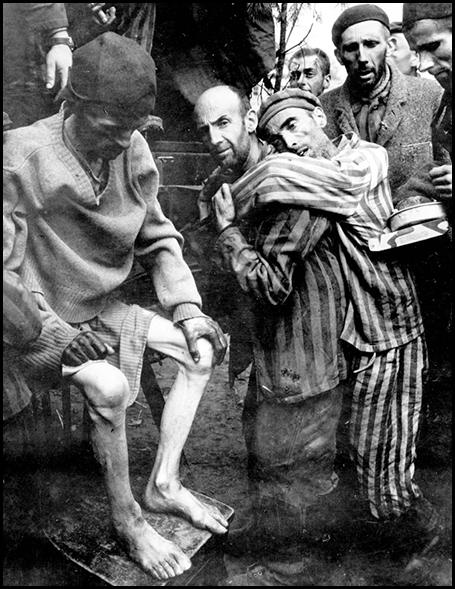
9.2 Unknown photographer. Prisoners Awaiting Evacuation to a Field Hospital, Wöbbelin, Germany, 1945. Dimensions variable. Gelatin silver print. Yad Vashem Archives, Jerusalem, Israel.
By the end of 1946, there were approximately 250,000 Jews living in DP camps. Although the Jewish refugees regarded the camps as a temporary arrangement, and
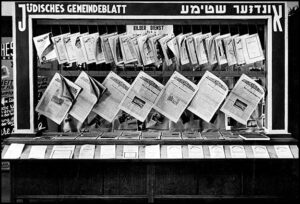
9.3 Unknown photographer. Jewish newspapers, exhibited at Bergen-Belsen. Dimensions variable. Gelatin silver print. Yad Vashem Archives, Jerusalem, Israel.
despite the filthy and wretched physical conditions, the enduring survivors took it as a call to action and transformed the DP camps into cultural centers of education, social activity, and renewal. The Jewish DPs set up educational institutions, published more than 70 Jewish newspapers, initiated commemoration projects, and even established theaters and orchestras. It was a first step in coming back to life, a place where Jews could restructure themselves emotionally, politically, and spiritually and find a way forward.[ii] Nevertheless, despair persisted. Survivors suffered from the effects of the Holocaust for their entire lives and often passed on their existential angst to the next generations, now known as transgenerational trauma.
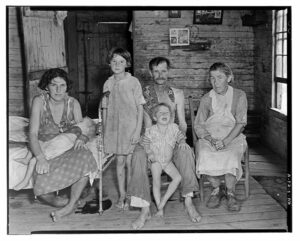
9.4 Walker Evans. Sharecropper Bud Fields and his family at home, Hale County, Alabama, 1935. Dimensions variable. Gelatin silver print. Library of Congress Prints and Photographs Division Washington, D.C.
Shoah photographs, like those of the FSA Great Depression collection, are not nostalgic or sentimental—they recall traumatic experiences that have been passed on to others. The power and authenticity of Holocaust photographs is in their numbers – over two million Shoah photographs are known to have been collected and identified to some extent. Their communal whole reflects a demented German society that sought to determine Germanness and who gets to claim it. This reflects the phrase the nineteenth-century German nationalist historian Heinrich von Treitschke popularized: “The Jews are our misfortune,”[iii] which was later adopted by the Nazi publication Der Stürmer.
This is why we save photographs, even of people we do not know, because in the end we share the same fate – dust motes – and photographs act as memorials. That said, viewing these images of the past allows us to recognize the present it produced, and to question the present, therefore, is to question the past. Ashes, bones, ruins, and trauma can be seized as an opening for change, thus turning the past into something that will improve the present.
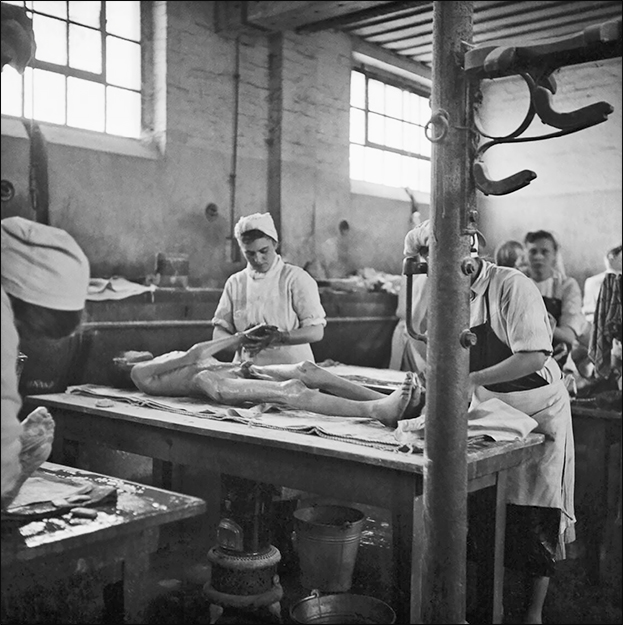
9.5 An emaciated and filthy man, who was not able to walk due to malnutrition and sickness, was washed by German nurses and orderlies on one of the tables in the cleansing station at the newly established hospital at Hohne Military Barracks, nicknamed the “Human Laundry.”
As William Faulkner wrote in Requiem for a Nun (1950): “The past is never dead. It’s not even past.” Every moment of a person’s past makes up who that individual is—the past lives on within each of us. This dovetails into Marianne Hirsch’s concept of postmemory, which “describes the relationship that the ‘generation after’ bears to the personal, collective, and cultural trauma of those who came before — to experiences they ‘remember’ only by means of the stories, images, and behaviors among which they grew up….”[iv] This is evident in the Shoah photographs that can take one back in time, acting as a lightning bolt, firing up the brain and retrieving feelings and memories, for better and worse, making a case for how past experiences persist and influence the present.

9.6 Unknown photographer. A young girl suffering from typhus recovers in her new cot, Bergen-Belsen, No 3 Camp, 1945. Dimensions variable. Gelatin silver print. Imperial War Museums, UK.
The explicit photographs made by the Germans present the experience of brutal subjugation and bring forth never-ending tears and sorrow. Controlling the ability of Jews to make their own images was yet another Nazi method to make Jews invisible. A lack of a shared reality can tear a country apart. In hindsight, this split decided Germany’s fate: it could not exist as a country where those in power dedicated themselves to the destruction of those who did not fit into their world view. This rejection of collective narratives lead to the downfall of German society.
The other side of this coin raises the question: When might it be better to declare amnesty and allow room to forget?[v] Should we make allowances for Germany’s national insanity and the failure of its moral compass? Did the German people’s willed, communal amnesia facilitate Germany’s astonishing reboot after World War II? Can vivid visual reminders sow the seeds of PTSD in the victims and their descendants? Given time and distance from trauma, can there be a space for forgiveness that is necessary to achieve reconciliation? Is it possible to make what happens tomorrow more important than what happened yesterday? Is what the Germans of that time did unforgivable? Do the sins of the fathers and mothers pass on to future generations? If so, what, if anything, do today’s Germans owe to contemporary Jews? How can nations and people best deal with past wrongs?[vi]
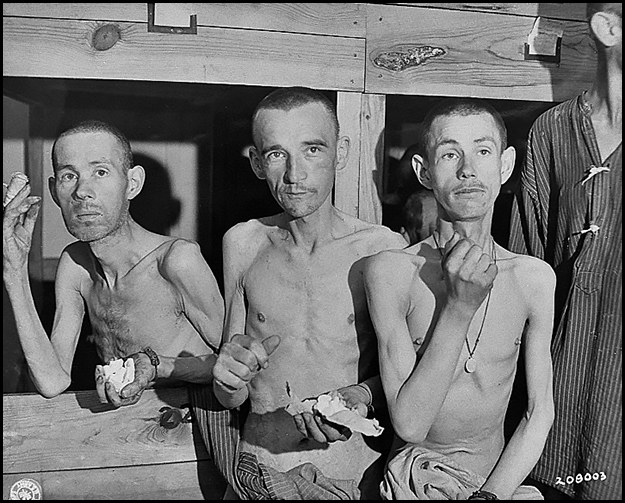
9.7 J. Malan Heslop, U.S. Army Signal Corps photographer. Three survivors suck on sugar cubes provided by American soldiers in the infirmary barracks for non-Jewish prisoners in the Ebensee concentration camp, Austria, May 8, 1945. Dimensions variable. Gelatin silver print. United States Holocaust Memorial Museum, Washington, DC.
For forgiveness to even be a possibility victims must be granted agency. Holocaust victims were denied the ability to represent themselves. This forced cultural eradication typifies the plight of any unwanted group, especially refugees who are considered to be a burden as they have no immediate resources. Understand that German white biological citizenship legally declared German Jews to be neither “white” nor “European” and thus could never be German. These false claims, turned to laws, were buttressed by U.S. eugenics movement,[vii] which Hitler greatly admired.
Ordinary Becomes Extraordinary
What are the conditions of becoming visible and gaining presence in the overall picture of the world? Photographic presence and absence can happen in a variety of ways. Photographic images can generate, highlight, select, and obscure persons, objects, events and relations; they can render them special, ordinary, normal, or boring. While society treats the photographic image as a valid representation of someone or something absent, the notion of presence is of high social and political importance. And when artists, curators, or algorithms select, compose, contextualize, or fragment art, this is far from a neutral act—it directly impacts our world-view. German intimidation, terror, and sadism choked off self-expression. Who knows the art and literature that was never made, the religious and scientific ideas that remained unwritten, and ideas unthought because of authoritarian policies.
It is critical to give individuals and groups the ability to depict themselves as opposed to having their identity imposed upon them. The freedom to express one’s distinctiveness is the ability to ask and answer the question: Who am I? Such an act allows a more meaningful self to develop, one that authors its own story. In turn, this encourages one to place greater value on their own and others’ lives.
Post-Holocaust photographs overcome their ordinariness by becoming physical objects of affirmation. Being able to make photographs of the birth of a child, a bar/bat mitzvah, or a wedding once again gave European Jews the ability to document authentic communal and private life passages. Such photographs were a pursuit towards reclaiming and reshaping their lives.
The ability to make familiar photographs allowed the people in the DPs to turn the ordinary into the extraordinary; they were able to revive their ability to be self-actualizing, rather than subjected to the rules of the dominant culture. This allowed everyday snapshots to play a social role in the unraveling of imposed restrictions and discrimination of the dominant Christian-based society. When juxtaposed to Nazi-made photographs, we can see how the story of the Shoah is derivative and contingent, and that nothing is immutable, even enormous tragedies.
Being able to once again carry one’s own camera declares intent, a way to express appreciation of the subject in front of your lens, to record a sense of your subject. The concentrated act of looking can generate a sense of action, awareness, and empowerment that can alter both the subject and the maker as one absorbs the scene. Images made by the DPs could induce a social stream of consciousness, acting as the social media in the DP camps. Their lack of artifice communicates the essence of a common experience as opposed to creating a skillful special scene. The banality of these snapshots forms a foundation from which exceptional expression can emerge.[viii] It is an example of how the camera can teach one to see more clearly as you are both in and outside of the moment about to be captured. It acts as a confirmation of the accepted communal photographic reality, an act of speech and engagement, which can be shared with others by declaring: This is who I am, I was here, and this is how I was feeling. The photographs became another way to fill the void, the absence of all that was loss, and assist in forming a new identity. Additionally, since cameras and supplies were in short supply each image became a more valuable statement that was capable of merging the natural and artificial – the person and the machine.
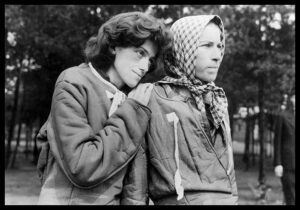
9.8 Two Women Survivors After Liberation, Bergen-Belsen, Germany, April 1945. Dimensions variable. Gelatin silver print. Yad Vashem Archives, Jerusalem, Israel.
The analog nature of the Shoah photographs makes them containers of accuracy and truth. Their physicality grants them the authority to show viewers what they could have expected to see if they had been there themselves. Digital imaging and artificial intelligence have put an end to that trust and add urgency to a question first raised by Photoshop more than 30 years ago: How much longer will we be able to trust what we see? Our digital world makes it easier for intentional misinformation to influence people. As Helen Lee Bouygues of the Reboot Foundation states: “the longer young adults were on TikTok, the more they believe what they see.”[ix]
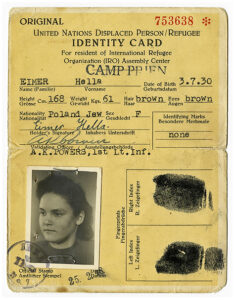
9.9 Helen (Hella) Eimer’s DP Camp identification card, Priem, Waldstadt, Germany, February 25, 1948. Dimensions variable. Gelatin silver print. United States Holocaust Memorial Museum, Washington, DC.
In 1965 James Baldwin wrote an essay for Ebony magazine titled “The White Man’s Guilt,” stating: “The great force of history comes from the fact that we carry it within us, are unconsciously controlled by it in many ways, and history is literally present in all that we do. It could scarcely be otherwise, since it is to history that we owe our frames of reference, our identities, and our aspirations.”[x]
The Axis powers and their enablers identified Jews as “them,” not part of “us,” rendering them “absent”— taking away their social identity and history. Their representations purposefully failed to convey what was lost when they were gone as well as why Jewish cultural absence matters. They intended to extinguish Jews from history, which is why Nazis banned and burned books: to erase and rewrite history. The Nazis planned to make a museum memorializing the elimination of the Jewish scourge from the planet.[xi]

9.10 Unknown photographer. Rudolf Gruber holds a name card intended to help any surviving family members locate him, Kloster Indersdorf, [Bavaria; Munich] Germany, October/November 1945. Dimensions variable. Gelatin silver print. United States Holocaust Memorial Museum, Washington, DC. This photograph was published in newspapers to assist in reuniting the family.
There’s no such thing as life without bloodshed. I think the notion that the species can be improved in some way, that everyone could live in harmony, is a really dangerous idea. Those who are afflicted with this notion are the first ones to give up their souls, their freedom. Your desire that it be that way will enslave you and make your life vacuous.[xiii]
As part of this post-traumatic effort to reclaim their history, Jewish journalists and scholars began collecting and documenting their stories in the DP camps and publishing them in their own journals, such as From the Destruction. Over 10,000 testimonies were collected by DP historical commissioners that allowed survivors to tell their own stories with the hope that their voices would help bring perpetrators to justice.
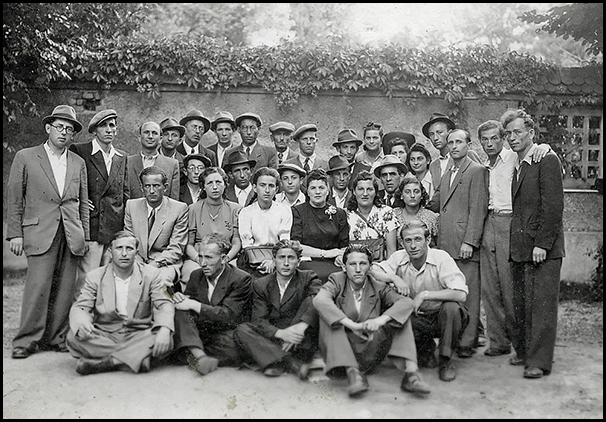
9.11 Unknown photographer. Group portrait of displaced persons, Eggenfelden DP camp [Bavaria] Germany, 1947-1948. Dimensions variable. Gelatin silver print. United States Holocaust Memorial Museum, Washington, DC. Among those pictured is Zvi Herschel (seated in the back row, second from the right).
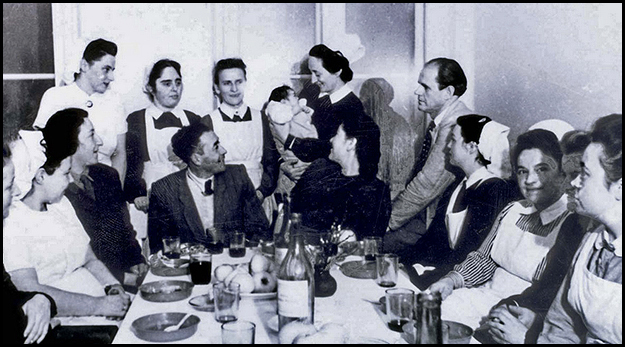
9.12
Unknown photographer. Festive gathering marking the birth of the thousandth baby in the Bergen-Belsen DP camp, Germany, 1948. Dimensions variable. Gelatin silver print. Yad Vashem Archives, Jerusalem, Israel.
In the photograph: the baby, Chana Mincer (Simmonds), born January 9, 1948, her parents, and nurses.
DP camp educators had to teach traumatized young people who had lost their childhood, who did not share a common language, and had either lost their knowledge and skills during the war years or never had an opportunity to learn them. Additionally, there was a shortage of classrooms, textbooks, and other educational equipment and supplies. At first, there were no professionally-trained teachers in most of the DP camps. However, skilled teachers were sent from Eretz Israel,[xiv] the U.S., and England who taught academic and trade courses.
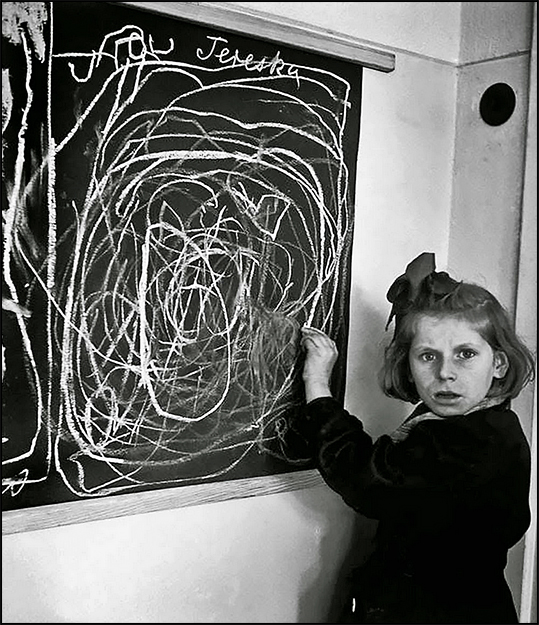
9.13 David Seymour (aka Chim). Tereska, a child in a residence for disturbed children. She drew a picture of “home” on the blackboard. Poland, 1948. Dimensions variable. Gelatin silver print. UNICEF/Magnum.
Cultural activities encouraged spiritual rehabilitation and led to the creation of artistic and cultural activities including orchestras and theater groups. In addition, DP sports clubs and competitions were started so survivors could begin a return to normality. Orthodox Jews began a revival of religious customs and schools (Yeshivas) to study the Torah and Jewish philosophy.
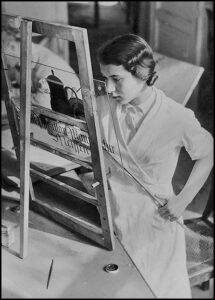
9.14 Unknown photographer. Woman painting on glass in the Stettin DP camp, Germany (today Szczecin, Poland). Dimensions variable. Gelatin silver print. Yad Vashem Archives, Jerusalem, Israel.
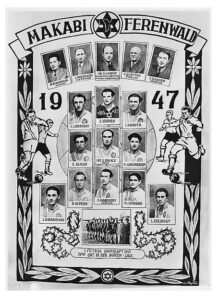
9.15 Unknown photographer. Composite photograph of the Maccabi soccer team, Foehrenwald DP camp, [Bavaria; Wolfratshausen] Germany, 1947. Dimensions variable. Gelatin silver print. United States Holocaust Memorial Museum, Washington, DC.
For the first time in years, the diverse participants in these activities were again openly able to utilize the language of photography to depict their activities, which was essential for expressing and understanding their situation. Moving past their victimization, their new self-made images became an important ingredient of a cultural transition that embraced a new outlook and set values. Such nascent images help solidify the formation of a revitalized civilization by forming a prism of resilience through which the DP’s could become pioneers and build a new reality out of the cinders.
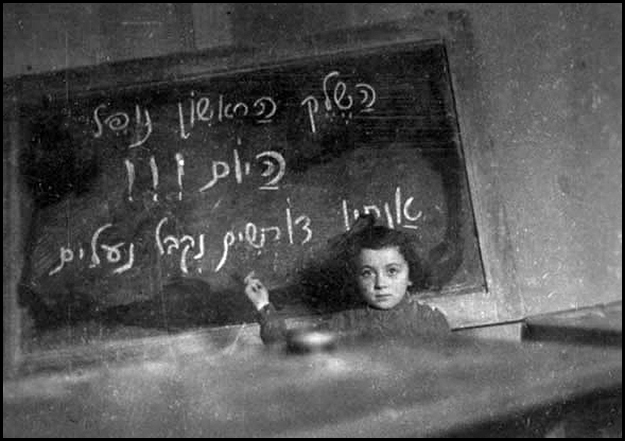
9.16 Unknown photographer. Hebrew lesson at the Bergen-Belsen DP camp, circa 1945-1946. Dimensions variable. Gelatin silver print. Yad Vashem Archives, Jerusalem, Israel.
Written on the blackboard: “Today the first snow is falling!!! We demand shoes.”
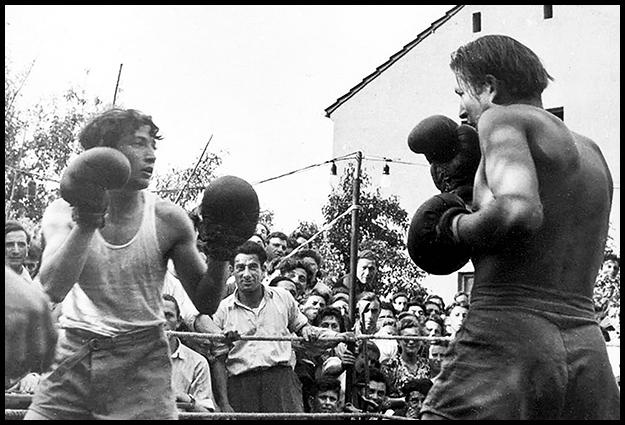
9.17 Boxing match at the Zeilsheim DP camp, Germany. Yad Vashem Photo Archive, Jerusalem, Israel.
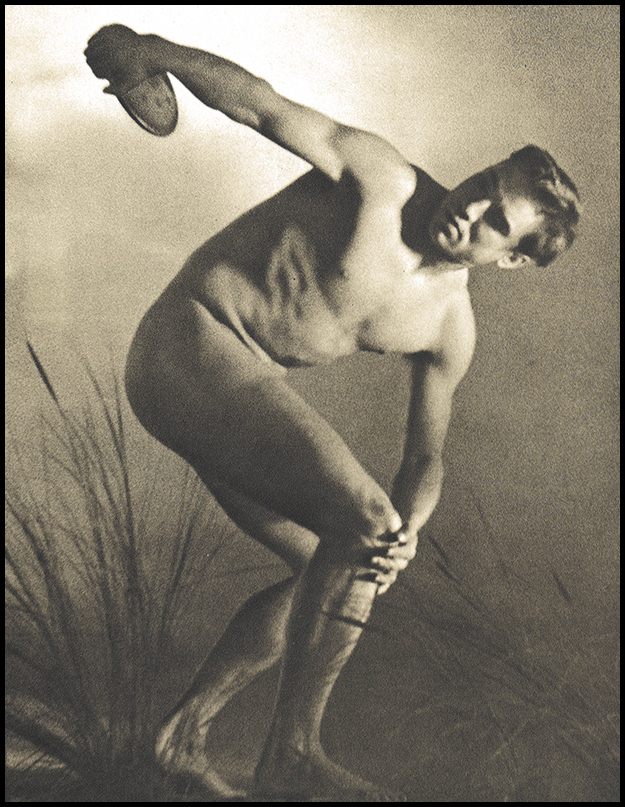
9.18 Leni Riefenstahl. Living Statue, 1937. Dimensions variable. Gelatin silver print. Schönheit im Olympischen Kampf (1937), Deutscher Verlag in Berlin, Germany.

9.19 Charles Atlas. Beach Bully: Don’t be a 97-pound (44 kg) weakling, 1953. 7 x 10.25 inches. Halftone color printing.
Immigration & Emigration[xv]
U.S. President Truman issued the Truman Directive on December 22, 1945, which instructed State Department consular officials to give preference to DPs within the existing immigration quotas. Truman did not believe that Congress would be willing to expand the quotas, which had been in place since 1924, even in response to an overwhelming humanitarian need. The State Department, the FBI, and even FDR claimed that Jewish immigrants could threaten national security. As historian Deborah Lipstadt writes in Beyond Belief: The American Press And The Coming Of The Holocaust, 1933-1945 (1993), The New Republic portrayed the government’s attitude as “persecuting the refugee.” By turning away the surge of Jewish refugees who sought to escape Europe in the 1930s and early 1940s, it is also a stain that Americans not reckoned.[xvi]
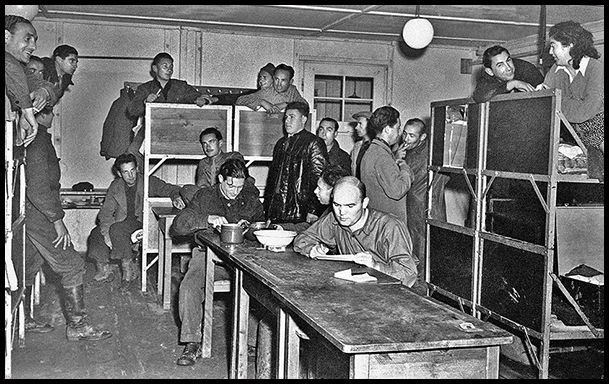
9.20 Unknown photographer. Jewish displaced people after the war at a camp at Feldafing, Germany, October 5, 1945. AP Photo.
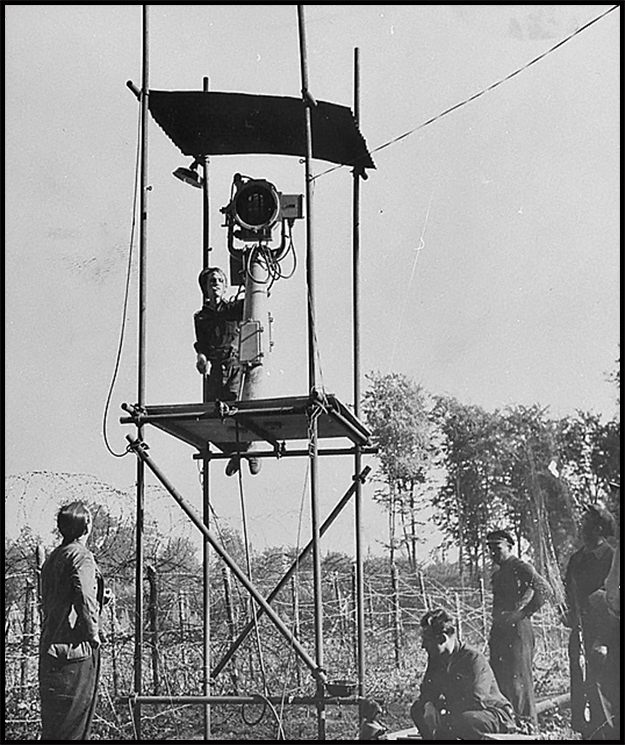
9.21 Unknown photographer. A British soldier guards the Poppendorf DP camp from a searchlight tower, 1947. Poppendorf, Germany. Dimensions variable. Gelatin silver print. United States Holocaust Memorial Museum, Washington, DC.
In 1948, Congress passed the Displaced Persons Act, authorizing 200,000 displaced persons to enter the United States without being counted against the immigration quotas. The act did not include any special provisions for Jewish DPs. However, between the establishment of the DP camps in 1945 and the closure of the last camp in 1957, approximately 140,000 Jewish Holocaust survivors emigrated to the United States.
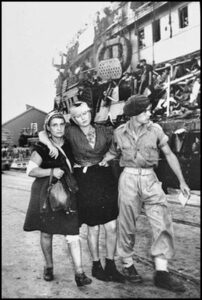
9.22 A British soldier removes refugees, wounded resisting the British, from the ship Exodus 1947, Haifa, Palestine, July 20, 1947. Dimensions variable. Gelatin silver print. United States Holocaust Memorial Museum, Washington, DC.
The survivors in the European DP camps focused their efforts on emigration from Europe to build new and productive lives elsewhere. Many of the DP camp residents strongly declared their intention to move to British Mandatory Palestine (pre-1948 Israel), where the British tightly limited Jewish emigration. Avraham Sadeh, in describing his return to Poland after the war, asks the question that many liberated survivors asked themselves: “I was demobilized from the army. I walked around the streets and didn’t know where to go. It was obvious to me that I had to get to Israel, but how?”[xvii]
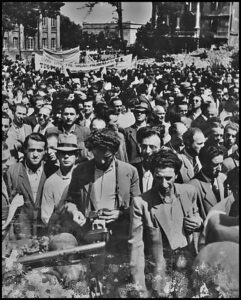
9.23 Unknown photographer. Protest demonstration at a DP camp in Germany against the British returning the ship Exodus, July 1947. Dimensions variable. Gelatin silver print. YIVO Institute, New York, NY.
World War II can be seen as the ultimate persecution of the undesirable neighbor, an extreme violation of the fundamental concept of what it means to be human. What survivors like Avraham Sadeh realized was that Jews desperately required a new Noah’s Ark that would transport them above the deluge of tyranny to a space of their own. The survivor’s ugly scars were vivid reminders that fundamentally nothing had changed for Jews since the time of Moses (1300 BCE). Although circumstances, details, names, and settings will change, similar events will repeat themselves, making it evident that passivity was not an option.[xviii] The consciousness of being different and the determination to survive meant European Jews had to take immediate, assertive action to ensure their safety, assert their Jewish identity, become self-reliant, and control of their fate by starting a new life. After having been vaccinated with the malice of centuries of rejection by dominate Christian and Muslim societies, many Jews saw mass emigration as a necessity to make the renewal of the ancient Jewish desert homeland a safe haven a reality.
A Yiddish song, Where Can I Go, written in the aftermath of World War II, points out how doors were closed to Jews seeking refuge. It concludes this way:
Now I know where to go
Where my folks proudly stand
Let me go, let me go
To the precious Promised Land
No more left, no more right
Lift your head and see the light
I am proud, can’t you see?
For at last I am free
No more wandering for me.
The importance of being able to make their own photographs again in the DP camps was a way for Jews to say: I refuse to be seen in the manner in which we have been depicted. I am not inferior. I am capable of being so much more than you have permitted me to me. These post-war photographs are visual markers of Jewish endurance and resilience. They remind us of the importance in finding the courage to stand-up to authoritarianism because evil and injustice are contagious and therefore need to be confronted and contained as early as possible to reduce its perilous spread.
Ponder what George Orwell wrote in 1942 about the position of Western pacifists vis-à-vis Nazi Germany that captures the veracity of the situation:
Pacifism is objectively pro-fascist.
This is elementary common sense.
If you hamper the war effort of one side,
you automatically help that of the other.[xix]
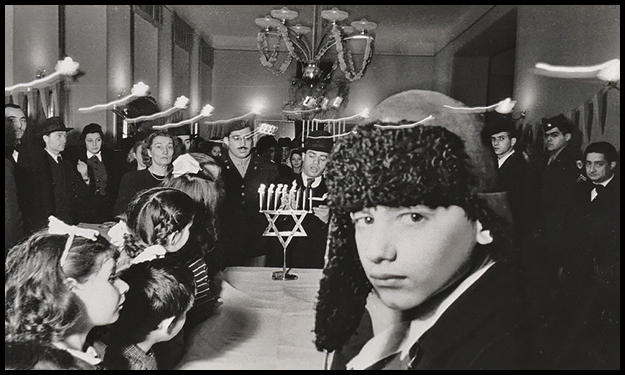
9.24 Unknown photographer. Channukah celebration, Vienna, Austria, 1946. Dimensions variable. Gelatin silver print. YIVO Institute, New York, NY.
To be continued: Essay 10 – “Home: Jewish Self-Determination & The Rebirth of Israel”
This series of essays has led to CEPA Gallery’s National Endowment of the Arts (NEA) supported, multi-prong project, “The Power of Resilience and Hope: Photography and the Holocaust – Then and Now,” which opens in January and runs through May 2024 with numerous community engagements and programing. Visit the Beta project website at https://rubymmerritt.wixsite.com/historytimeline
 ————————————————————————————————-
————————————————————————————————-The following statement reflects the interest of the author, Robert Hirsch, and not the position of VASA, its staff, editors or contributors.
————————————————————————————————-
Essay 9 Afterword: Israel and Hamas at War
As this essay is prepared for publication the world is grappling with the aftermath of Hamas’s gruesome, stomach-turning terrorist attack in Israel on October 6, 2023 during the Sukko holiday.
Murdering Jews is an end in its own right for Hamas, because they believe it fulfills a theological allegiance to Allah and the 1988 original Hamas covenant that states: “The Day of Judgment will not come about until Muslims fight Jews and kill them. Then, the Jews will hide behind rocks and trees, and the rocks and trees will cry out: ‘O Muslim, there is a Jew hiding behind me, come and kill him.’” 1 In 2017 Hamas altered their language from “Jews” to “Zionists” and “kill” to “resisting the occupation with all means and methods,” 2 but the meaning is the same: murder
Zionists = Jews.
Hamas’s covenant also states: ‘Israel will exist and will continue to exist until Islam will
obliterate it…’ This casts Jews as the eternal enemy of all humans and demonstrates how ultra-violent antisemitism is connected to the present and to the future. 3
Critically examining history is necessary to build a better future and serves as a reminder that antisemitism, one of the oldest forms of racism, is still alive and well even within the most enlightened spaces. When one says No to antisemitism, one is also taking a stand against all forms of hate and racism.
In terms of photography, Hamas nihilistically turns the lens on its own savage butchery and then circulates these immoral images as part of its campaign of genocide and terror upon the Jewish people while its leaders comfortably reside in Doha, Qatar.
Israel and the Ukraine share the same achievable outcomes, national survival, while living in proximity to enemies, whose objective is national annihilation.
Israel is not at war with the Arab Palestinians, Israel is at war with the genocidal Hamas and its enablers.
The path to co-existence and an end to the suffering of all involved will only be possible when Iran and its proxies, including Hamas, Hezbollah, Qatar, Syria, Yemen, and all who support these authoritarian regimes, 4 stop rejecting peace offers, seriously negotiate, and say YES to Israel’s peaceful right to existence.
Gazans should demand the release of the hostages and the punishment of Hamas and its enablers in exchange for peaceful co-existence, rebuilding, and free, supervised elections.
Now isn’t the time for silence. Jews well know that silence equals death. It is the moment to take a stand against all types of authoritarianism, whether political or theological.
References to statement
1 Israel Foreign Ministry – Jerusalem, https://irp.fas.org/world/para/docs/880818a.htm
2 Bruce Hoffman, Understanding Hamas’s Genocidal Ideology, The Atlantic, October 10, 2023, www.theatlantic.com/international/archive/2023/10/hamas-covenant-israel-attack-war-genocide/675602/
3 “Hamas: Covenant of the Islamic Resistance Movement (August 18, 1988), Jewish VirtualLibrary, Source: Yale Law School, www.jewishvirtuallibrary.org/hamas-covenant-full-text
4 Neil MacFarquhar, “The Proxy Forces Iran Has Assembled Across the Middle East,” The New York Times, October 27, 2023, www.nytimes.com/2023/10/27/world/middleeast/iran-proxy-militias.html?searchResultPosition=1 Also, Iran is receiving military support from Russia via the Wagner group and political support from China.
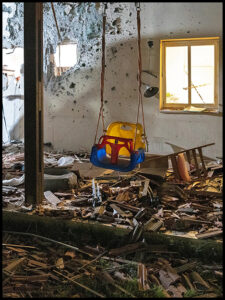
9.26 © Peter van Agtmael. The home of Yarden Roman-Gat, who is presumed to have been
kidnapped by Palestinian militants and taken to Gaza. Dimensions vary. Digital file. Magnum
for The New Yorker.
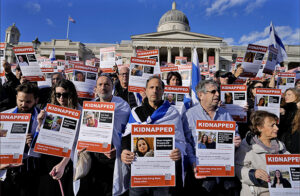
9.27 © Frank Augstein/AP. Large crowds of pro-Israel demonstrators gather in Trafalgar
Square, London, October 22, 2023, demanding the release of all hostages abducted from Israel
to Gaza by Hamas terrorists. Dimensions vary. Digital file.
New Notes
For Additional Reading
Antisemitism is not a Jewish problem and Jews are not the ones who are infected by it, so Jews should not be the only ones fighting to remedy it. What is happening in the U.S. now is not just a crisis for Jews. It is a failure for the entire country as it is an attack on the essence that makes us all humans.
“Biden-Harris Administration Releases First-Ever U.S. National Strategy to Counter Antisemitism,” www.whitehouse.gov/briefing-room/statements-releases/2023/05/25/fact-sheet-biden-harris-administration-releases-first-ever-u-s-national-strategy-to-counter-antisemitism/evan And: “Biden administration unveils strategy to counter antisemitism. The unprecedented National Strategy to Combat Antisemitism, announced Thursday afternoon, has sparked debate among Jewish organizations,” www.jpost.com/american-politics/article-744226
Biden Administration Releases Historic ‘Comprehensive and Ambitious’ Plan to Counter Antisemitism
www.algemeiner.com/2023/05/25/biden-administration-releases-historic-comprehensive-and-ambitious-effort-to-counter-antisemitism/
www.jns.org/jns/antisemitism/23/5/25/290892/
“Defining antisemitism: A vital step to unite voices against anti-Jewish bigotry, The U.S. government, 40 other countries and nearly 1,100 states, counties, city councils and other organizations have endorsed or adopted the IHRA definition,” www.jns.org/wire/defining-antisemitism-a-vital-step-to-unite-voices-against-anti-jewish-bigotry/23/5/25/290758/
Eugene Kontorovich, “The Biden Administration Redefines Antisemitism, And excludes today’s most pernicious form of Jew-hatred,” Tablet, July 12, 2023, www.tabletmag.com/sections/news/articles/biden-administration-redefines-antisemitism
Aviya Kushner, “We need to talk about RFK Jr.’s antisemitic conspiracy mongering,” Forward, July 17, 2023, https://forward.com/culture/554446/rfk-jr-antisemitism-conspiracy-theories-covid-ashkenazi-jews-caucasians/
The International Holocaust Remembrance Alliance’s (IHRA) working definition of antisemitism was adopted by more than 40 countries, high-profile universities and institutions, and is used by all U.S. executive departments and agencies that enforce Title VI civil-rights protections. The definition explains what constitutes antisemitism and why. It includes examples of delegitimization, demonization and double standards against Israel that move into antisemitism and makes clear that “criticism of Israel similar to that leveled against any other country cannot be regarded as antisemitic.” It is common for opponents of Zionism to say that they are merely criticizing Israeli policies when they are actually opposed to the existence of Israel in any form.
https://www.jns.org/wire/hostility-against-jewish-students-ramps-up-on-campuses/23/6/9/293928/
US Jewish groups take no time in responding to White House antisemitism plan. Reactions are proving mixed; while groups finally have something to see, some are disappointed with the inclusion of a progressive alternative to the widely accepted definition put forth by the International Holocaust Remembrance Alliance. www.jns.org/jns/antisemitism/23/5/25/290936/
ADL CEO Jonathan Greenblatt, Special Envoy Deborah Lipstadt Discuss Biden Antisemitism Plan in Webinar
Lipstadt called the plan “something that transcends politics.”
https://jewishjournal.com/news/united-states/359372/adl-ceo-jonathan-greenblatt-special-envoy-deborah-lipstadt-discuss-biden-antisemitism-plan-in-webinar/
Lipstadt also argued that the plan recognizes that the antisemitism isn’t just a threat to Jews, but to democracy as a whole. Antisemites believe that “Jews are behind the scenes conniving, controlling, making sure things run to fulfill their own needs at the expense of everyone else’s needs” and people who believe that “don’t believe in democracy” and don’t believe their government has their best interests at heart, Lipstadt said. “What starts with the Jews doesn’t end with the Jews,” she later added.
Adam Kovac, “Elon Musk has made some disturbing comments about Jews. Here’s a list,” Forward, September 6, 2023. https://forward.com/news/550035/elon-musk-disturbing-comments-jews/
The Synagogue Attack Stands Alone, but Experts Say Violent Rhetoric Is Spreading
At his trial, the man who killed 11 at a Pittsburgh synagogue was portrayed as a lonely man engulfed in online extremism. Experts say many people fit that description.
https://www.nytimes.com/2023/08/04/us/pittsburgh-synagogue-shooting-antisemitism-bowers.html?searchResultPosition=2
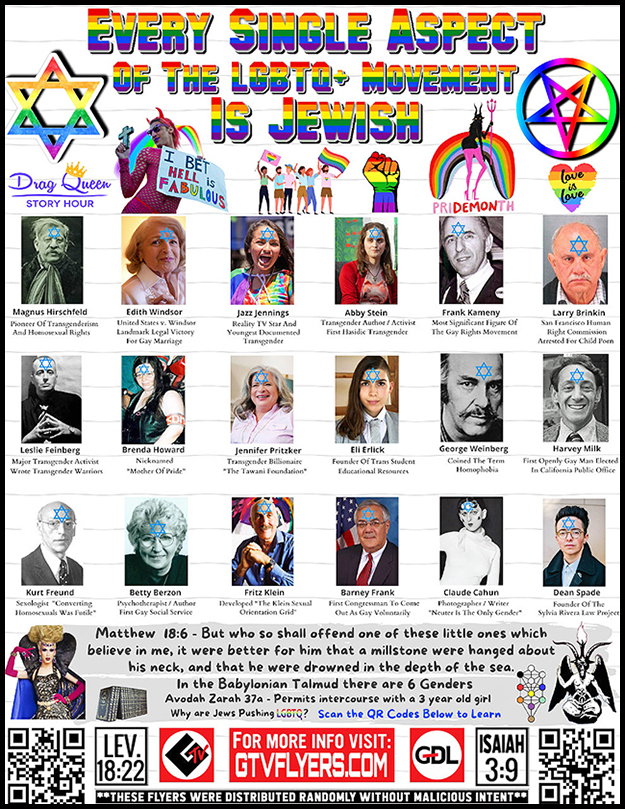
Goyem Flyers. “Every Single Aspect of the LGBTQ+ Movement is Jewish,” 2023. 8.5 x 11 inches. Electrostatic print.
Endnotes:
[i] Additionally, President Truman issued the Truman Directive on December 22, 1945, ordering that displaced persons receive preference under existing U.S. immigration quotas. This led to the immigration in the following two years of 22,950 DPs, about two-thirds of whom were Jewish. “The Harrison Report,” Jan 25, 2021, https://encyclopedia.ushmm.org/content/en/article/the-harrison-report
[ii] In Man’s Search for Meaning (1946) Viktor Frankl lays out three psychological stages a typical prisoner goes through. The first is shock, reflecting the initial reaction to the concentration camp horrors. Each prisoner experiences the total loss of their entire former life: family, friends, occupation, personal freedom, everything. “We really had nothing left…except our bare bodies—even minus hair; all we possessed, literally was our naked existence.” Apathy characterizes the second stage wherein the prisoner suppresses normal emotional responses to the horrors as a form of psychological defense. Lastly, upon liberation, a prisoner has to learn “how to be human again,” to resurrect normal human emotional responses and attempt to overcome their bitterness and disillusionment upon discovering their longed-for happiness remains elusive.
[iii] Heinrich von Treitschke Pronounces, “The Jews are Our Misfortune” (November 15, 1879), https://ghdi.ghi-dc.org/sub_document.cfm?document_id=1799
[iv] See: Columbia University Press, “An Interview with Marianne Hirsch,” https://cup.columbia.edu/author-interviews/hirsch-generation-postmemory
[v] See: Lewis Hyde, A Primer for Forgetting: Getting Past the Past (New York: Farrar, Straus and Giroux; 2019). The word amnesty comes from the Greek amnesia, which was a legalized form of forgetting that was invented about 400 BCE in Athens to help the country recover from a civil war. More recently, Spain enacted a “pact of forgetting” in 1977 after the death of fascist, dictator Francisco Franco. The law freed political prisoners and allowed those exiled to return to Spain, but also guaranteed impunity for those who participated in human rights crimes.
[vi] From 1945 to 2018, the German government paid approximately $86.8 billion in restitution and compensation to Holocaust victims and their heirs. U.S. Department of State, “The JUST Act Report: Germany,” www.state.gov/reports/just-act-report-to-congress/germany/
Germany also agreed for the first time to specifically fund Holocaust education — with 10 million euros allotted for 2022, 25 million euros for 2023, 30 million euros for 2024 and 35 million euros for 2025. Kirsten Grieshaber, “Germany marks 70 years of compensating Holocaust survivors,” September 15, 2022, AP News, https://apnews.com/article/holocaust-survivor-compensation-fund-germany-0d35aa1cba7756d1b9b6008e9d7841b7
[vii] See: “Eugenics and Scientific Racism,” National Human Genome Research Institute, May 18, 2022, www.genome.gov/about-genomics/fact-sheets/Eugenics-and-Scientific-Racism
[viii] Imagemakers who were disenchanted with formal, modernist expectations about how the photograph should look and what it should picture helped launch a movement based on the casual and unconventional vocabulary of the snapshot, which became known as the snapshot aesthetic. It can be seen in the work of Lisette Model, Robert Frank, Lee Friedlander, Garry Winogrand, and Nan Golden. They were relying on a gut-level response to their subjects that would clarify, but not define, life as they found it, while incorporating the diverse traditions of art and documentary photography. Model stated: “I am a passionate lover of the snapshot, because of all photographic images it comes closest to truth […] The snapshooter’s […] pictures have an apparent disorder and imperfection, which is exactly their appeal and their style. The picture isn’t straight. It isn’t done well. It isn’t composed. It isn’t thought out. And out of this imbalance, and out of this not knowing, and out of this real innocence toward the medium comes an enormous vitality and expression of life. (Elizabeth Sussman, Lisette Model, New York: Phaidon Press, 2001, unp.)
[ix] Tiffany Hsu and Sapna Maheshwari, “The Titanic Truthers of TikTok,” The New York Times, June 16, 2023, www.nytimes.com/2023/06/16/business/titanic-tiktok-misinformation.html?searchResultPosition=1
[x] “James Baldwin and the Trap Of Our History,” TIME, August 29, 2016, https://time.com/4457112/james-baldwin-eddie-glaude/
[xi] See: Bernard Weinraub, “Trove of Judaica Preserved by Nazis to Tour U.S.,” The New York Times, September 20, 1983, Section A, Page 18, www.nytimes.com/1983/09/20/us/trove-of-judaica-preserved-by-nazis-to-tour-us.html
[xii] See: Magda Teter, Christian Supremacy: Reckoning with the Roots of Antisemitism and Racism, Princeton: Princeton University Press, 2023.
[xiii] Richard B. Woodward. “Cormac McCarthy’s Venomous Fiction,” The New York Times, April 19, 1992, https://archive.nytimes.com/www.nytimes.com/books/98/05/17/specials/mccarthy-venom.html?_r=2
[xiv] During the League of Nations mandate period (1920–1948) the term “Eretz Yisrael” or the “Land of Israel” was part of the official Hebrew name of Mandatory Palestine.
[xv] An emigrant is someone who emigrates – moves away from a country. An immigrant is someone who immigrates – moves to a different country. Both terms can apply to the same person – a person must first emigrate to immigrate.
[xvi] See: Dara Horn, “Come Here to Me, You Fortunate Citizen of the World,” Jewish Review of Books, Summer, 2023, https://jewishreviewofbooks.com/holocaust/14402/come-here-to-me-you-fortunate-citizen-of-the-world/
[xvii] Yad Vashem Archives, O.3/3975 [Hebrew] www.yadvashem.org/articles/general/anguish-of-liberation-and-return-to-life.html#footnote5_0df3ssm
[xviii] Even now, we are now in another cycle of escalating, worldwide antisemitism that continues to demonize Jews as bogeymen in which the same old visual tropes are endlessly recycled by such U.S. hate groups as the neo-Nazi Goyim Defense League.
[xix] George Orwell, “Pacifism and the War,” Partisan Review, August-September 1942.
